| This ASW-6 report consists of two sets of ASW-6 forms. The first set (VC-1 ASW-6 report 9-43) concerns the depth bomb attack against U-220. The second set (VC-1 ASW-6 report 9A-43) concerns the Mark 24 Mine attack on U-256. These reports share enclosures A through D. |
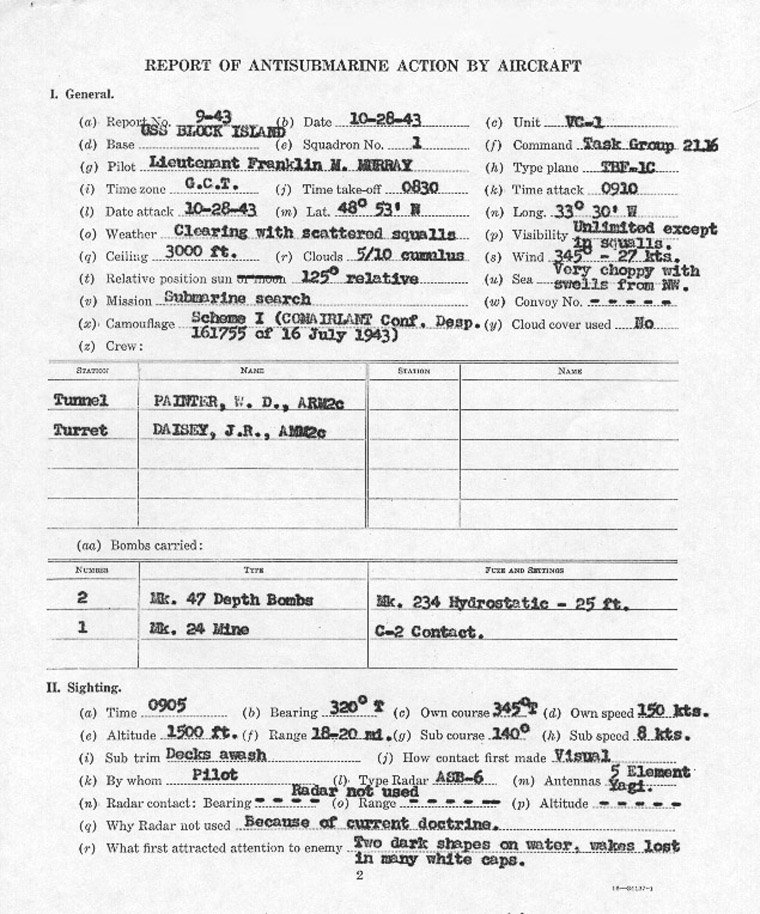
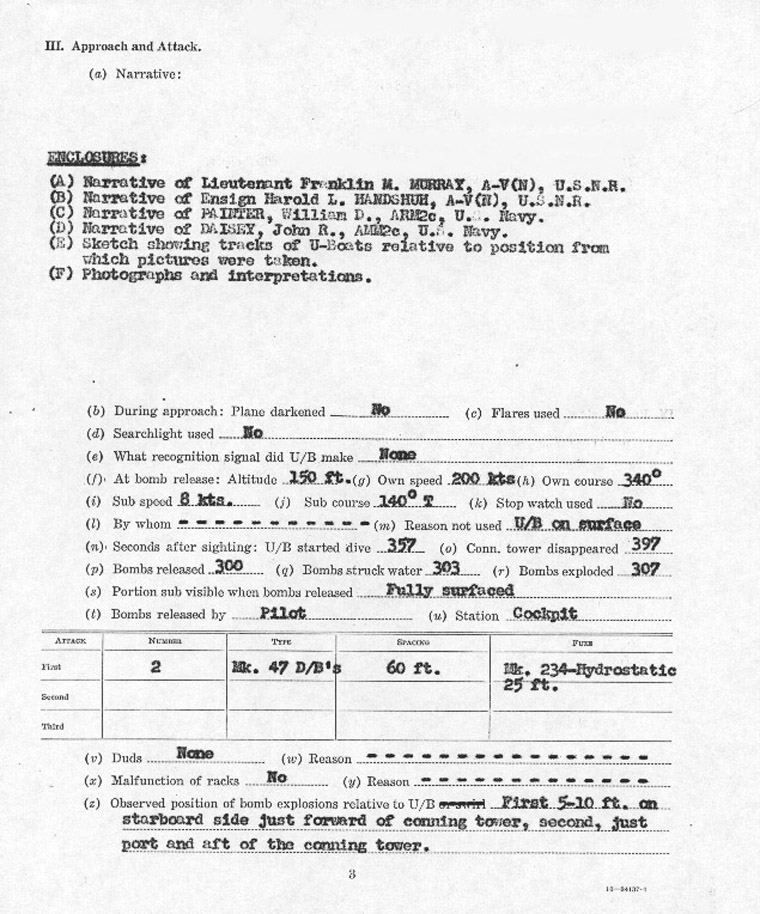
COMPOSITE SQUADRON ONE |
||
28 October 1943. |
||
NARRATIVE OF DEPTH BOMB ATTACK |
||
| 1. The airplanes were flying at an altitude of 1500 feet on a routine submarine search. The weather was clear, but there were numerous cumulus clouds, base 1500-3000 feet, providing 5/10 coverage. Except in the squalls, the visibility was unlimited. Visual contact was made by the TBF pilot on two enemy submarines, bearing 3200, about 20 miles. The pilot’s attention was attracted by two dark objects on the water at extreme range. The submarines were bearing 3370, 60 miles from the carrier. | ||
| 2. The pilot immediately increased speed, signaling the fighter, flying on his starboard wing, to proceed on in for a strafing attack prior to the bombing run. A contact report was made but not received by the ship. No cloud cover was used and apparently the gray-white camouflage of the plane against a cumulus cloud background enabled the TBF pilot to effect almost complete surprise. AA fire by the submarine did not commence till the pilot pushed over for his attack run. | ||
| 3. The U-boats were cruising trimmed down at a speed of about 8 knots, not more than 200 yards apart, on a course of 1400T. The decks of the smaller submarine were awash and the larger one seemed trimmed down a little further, with only the conning tower visible. Both U-boats were painted a very dark almost black color, through the TBF gunner, who later had a very clear view of the larger submarine, believed the color to be a dark green. There was an indistinguishable numeral or insignia on the side of the conning tower of the larger submarine. The paint of both seemed to be in good condition. | ||
| 4. The fighter swept to port of the TBF on the way in and made a single strafing run on the nearer and smaller of the two U-boats coming in directly on its starboard beam. The TBF followed with his attack almost instantaneously, causing the fighter to pull up from his strafing, but not before the TBF pilot had observed the fighter’s bullets as well as his own striking all around the conning tower of the smaller U-boat. | ||
(3a) |
||
COMPOSITE SQUADRON ONE |
||
28 October 1943. |
||
NARRATIVE OF DEPTH BOMB ATTACK – CONT’D |
||
| The TBF dropped two Mk.47 depth bombs, intervalometer setting of 60 feet, fused to explode at 25 feet. Airspeed was 200 kts., altitude 150 feet, target angle 0200. Right after this attack the fighter climbed to 5000 feet to give the ship a radar bearing. He also turned on his ABK, Channel 4. |
||
| 5. The radioman saw the bombs strike the water on the starboard side of the submarine, and all three of the TBF crew as well as the fighter pilot observed the explosions of both bombs, one on the starboard side just forward of the conning tower and one on the port side just aft of the conning tower. Unfortunately the K-20 camera had jammed and no pictures could be taken from the TBF stinger. Quick work on the part of the radioman cleared the camera and enabled the taking of the few pictures accompanying the report. Obviously these were taken from too great a range to be as useful as desired. | ||
| 6. The explosion of the bombs appeared to straddle the U-boat with the plumes completely hiding it from view. As the spray subsided, the attacked U-boat entered into a tight turn to starboard losing way and apparently listing noticeably to starboard. By the time it had turned about 1800 it began to settle with complete loss of forward motion. Then suddenly the stern appeared in the air, screws showing, and after hanging there briefly, the U-boat disappeared about ninety seconds after the attack at an angle of 450 or more. There is one photograph that tends to confirm this. Other photographs indicate a possible large oil patch around the sinking U-boat despite the fact that the oil slicks were not observed by any of those present. The condition of the sea may have been responsible for this. It was very choppy, there was a lot of wind, and there was also a fairly heavy ground swell out of the northwest. Furthermore, with the sun behind clouds most of the time there would be no reflection from oil on a dark sea. | ||
(3b) |
||
COMPOSITE SQUADRON ONE |
||
28 October 1943. |
||
NARRATIVE OF DEPTH BOMB ATTACK – CONT’D |
||
| 7. In addition to this very sudden and sharp angle of dive there were many air bubbles about 10 to 15 feet in diameter. Although these were noticed right after the attack, they became so numerous where the U-boat settled that the whole patch of water at that spot appeared to be boiling. Because of the intense AA fire put up by the larger U-boat, the plane could not get in to take pictures of this. | ||
| 8. No other indications of damage were seen either by the attacking planes or by other planes sent to investigate the scene of contact later in the day. Through fluorescein dye markers were dropped, the condition of the sea made them ineffective after a few minutes. The narrative of the attack on the larger of the two U-boats is attached to the other ASW-6 report of this action. Suffice it to say that for 35 minutes after this first attack, the larger U-boat stayed on the surface, and after it dove, the plane was in the area for another 30 minutes. During this entire time no further trace of the first and smaller submarine was seen. | ||
| 9. There was no antiaircraft fire observed from the smaller sub though a heavy barrage came from the larger one. AA fire seemed to come not only from the after platform but also from a point near the forward end of the conning tower. Both tracers and explosive shells were used, the forward fire being from a single spot at the apparent rate of 60-80 rounds per minute. This indicates one of the AA guns may have been 37 or 40mm. The gun crew seemed to be poor deflection shots. No personnel were observed topside on either sub at any time, but conditions of the attack were such that they must have been present. | ||
(3c) |
||
COMPOSITE SQUADRON ONE |
||
28 October 1943. |
||
NARRATIVE OF LIEUTENANT FRANKLIN M. MURRAY, A-V(N), U. S. N. R. |
||
| 1. I departed on mission from U.S.S. BLOCK ISLAND at 0845 GCT on 28 October 1943 in TBF-1C airplane, Bureau Number 15482. Flying a course of 3450T at an altitude of 1500 feet, at 0905, I saw two dark objects in the water 250 on port bow about 20 miles. I immediately headed towards them, telling my crew to stand by for an attack. I zoomed to get the fighter joined up and then verified my first impression that the two objects were submarines with my field glasses. The submarines were on course of 1400T, speed about 8 knots, 200 yards apart and abreast. The nearer sub had its deck out of the water while only the conning tower of the other was visible. I waved the fighter out to the side so that we could make the attack from different angles. I called the ship on the ABK and ran over the arming check off list to make sure that everything pertaining to ordnance was in working order. | ||
2. I made my attack from 200 on the closer submarine’s starboard bow, while Ensign HANDSHUH made his approach from the starboard beam. The attack took both submarines completely by surprise until both planes started strafing the U-boats. The conning tower of the closest submarine was covered by gunfire from both planes. It wasn’t until I was in my final dive to drop the depth bombs that I noticed that the U-boat farthest away was the larger of the two, but by then I was in position to drop. I did not see the depth bombs enter the water but the explosions of the charges came from both sides of the U-boat so that it was out of sight momentarily until the water subsided. About this time I noticed that gunfire was coming by me on both sides so I jinked around trying to get a better view and also a picture of the bombed sub. My radioman called me and told me that the camera had jammed and he did not get a picture of the drop or the explosion. All of the gun fire came from the large sub that I had not bombed. No fire came from the bombed sub. This sub that we had bombed lost all forward motion and had skidded in a turn to starboard of about 1800. Gunfire from the other sub became rather intense, so I climbed to about 2500 feet. 80 to 90 seconds after the bombing, the stern of the bombed sub suddenly arose out of the water at an angle of at least 450, hung there momentarily and then slid under the water. By this time, the radioman had the camera working but we were too far away for the small K-20 to get the details. |
||
| ENCLOSURE (A) | ||
-1- |
||
COMPOSITE SQUADRON ONE |
||
28 October 1943. |
||
| NARRATIVE OF LIEUTENANT FRANKLIN M. MURRAY, A-V(N), U. S. N. R.-CONT’D |
||
3. During the attack the large sub had its deck out of the water, keeping up strong AA fire with the gun forward of the conning tower and the guns on the conning tower. After the first sub sank, the large sub tried to keep its bow pointed toward me, but still moving in a southeasterly direction. I called the ship and asked them if they received my first message. The ship replied negative but other pilots in the air had retransmitted the course and distance that Ensign HANDSHUH called in. The distance got mixed up so that we did not get any assistance. However, I heard the ship sending other planes vectors, but I didn’t pay any attention to them because I was busy jinking and watching the remaining sub. I wouldn’t let the fighter make more strafing runs because I thought we could keep drawing the gun fire from the sub, keeping it worried so it wouldn’t submerge in fear of an attack and thus enabling relief planes to make an attack. Once it made a pretense of diving, so I turned on my gun camera, which I had forgotten on my bombing run, and started in on a strafing run to get some pictures. On the way in, my left gun jammed and the sub started intense AA fire by my nose, so I pulled out and regained altitude.
|
||
| 4. At about 0945 the sub crash dived, so I immediately went in to drop my mine. My course was toward the sub’s port beam, altitude 200 feet, speed 150 kts. The mine was dropped, hitting the water 46 seconds after the disappearance of the conning tower, about 100 feet beyond the swirl. Ensign HANDSHUH and my crew saw the mine enter the water and begin its run. Before the mine’s wake disappeared from view, they observed it to turn 300 to port. | ||
| 5. I dropped a sono-buoy 5 seconds before the mine hit, but it did not work. I told both my crew to keep their eyes open for an explosion or a shock wave, neither of which was observed. | ||
| |
||
| Franklin M. MURRAY | ||
| ENCLOSURE (A) | ||
-2- |
||
COMPOSITE SQUADRON ONE |
||
28 October 1943. |
||
NARRATIVE OF ENSIGN HAROLD L. HANDSHUH, A-V, U. S. N. R. |
||
| 1. Departed U.S.S. BLOCK ISLAND in FM-1 airplane at 0845 GCT, 28 October 1943, in company with Lieutenant F. M. MURRAY who was in a TBF-1C airplane. | ||
| 2. On course 3450, 20 minutes out, Lieutenant MURRAY called my attention to two submarines out about 20 miles, bearing 3200 from us. I faintly heard Lieutenant MURRAY give contact report. I was on his starboard and I crossed to his port, starting a run on the starboard beam of the closer of the two submarines. | ||
| 3. They were side by side about 200 yards apart, approximate course 1400, speed about 8 knots. Deck of closer one was visible, but the further one just showed its conning tower above water. | ||
| 4. My run was about simultaneous with Lieutenant MURRAY’s depth bomb attack. I maintained fire around conning tower of nearer submarine until Lieutenant MURRAY was at close range on my starboard, then I pulled up over submarine and he made his depth bomb drop. Looking around I noticed the explosions had bracketed the closer sub, causing it to be entirely covered by the plumes of water. I continued to climb to 5000 feet so that the ship could get an accurate bearing and distance on me. | ||
| 5. As both planes passed the submarines, the larger one started firing on the TBF. | ||
| 6. The attacked sub then commenced a starboard turn of 1800 being followed by the other. As it made good its turn, it seemed to lose forward motion. Then its stern rose abruptly and it disappeared at an angle of at least 450. Violent turbulence of bubbles marked the area of sinking and no wake showed. As the sea was very choppy, no debris or oil was seen to rise and the dye markers dropped at the scene of attack were immediately dissipated. | ||
| ENCLOSURE (B) | ||
-1- |
||
COMPOSITE SQUADRON ONE |
||
28 October 1943. |
||
NARRATIVE OF ENSIGN HAROLD L. HANDSHUH, A-V, U. S. N. R. - CONT’D |
||
7. The other sub, now fully surfaced and obviously larger than the one sunk, started violent evasive action in area of attack. It held constant fire on both our planes and continued such maneuvers for 35 minutes til submerging.
|
||
| 8. Forty-five seconds after the conning tower disappeared, Lieutenant MURRAY dropped the mine. I saw it hit the water and start to turn left into the course of the sub. After it completed about a 300 arc, I could no longer see its wake. It seamed to be gaining depth as it progressed in its turn. | ||
| 9. We remained in the area for another 30 minutes when we returned to the ship as instructed. | ||
| |
||
| Harold L. HANDSHUH. | ||
| ENCLOSURE (B) | ||
-2- |
||
COMPOSITE SQUADRON ONE |
||
28 October 1943. |
||
NARRATIVE OF PAINTER, William Dale, 382 48 75, ARM2c, U.S. Navy |
||
| 1. While on sub-patrol on 28 October 1943, the pilot sighted two subs on the surface. The time of the sighting was about 0905 GCT. He told the gunner and myself to standby for an attack. | ||
| 2. I went over all the arming switches and got into position to take pictures of the bomb drop, but the camera jammed. I did not obtain the pictures of the drop, but saw the explosions which were well placed. The bombs seemed to straddle the sub, one on either side of the conning tower and when they went off the sub was completely covered with spray except for a portion of the bow. That was the first that I saw of the submarines. | ||
| 3. On our way out the unattacked sub started firing AA at us, all the way out until we were out of range. In the meantime, the sub we had dropped our bombs on started to turn. After going a short way it lost all forward motion, the bow went down and the stern came up until the screws were out of the water. It stayed this way for 8 to 10 seconds and then went down, leaving large bubbles and a boiling spot in the water. All this time the other sub followed it around staying on its port side and firing AA. When the one sub went down the other took up a zigzag course and when we circled, the sub would try and keep her bow on us so as to use her larger AA guns to keep us away. She kept this up for 30 or 35 minutes and then submerged. We then went in and dropped our mine. We saw the mine go into the water and make a port turn of 20 to 30 degrees. I did not see any shock waves or any indications of it going off unless it went off pretty deep. The sea was so rough that I don’t think we could have told if it went off of not. | ||
| 4. We circled for 30 minutes more and returned to the ship. | ||
 |
||
| William Dale PAINTER. | ||
| ENCLOSURE (C) | ||
COMPOSITE SQUADRON ONE |
||
28 October 1943. |
||
NARRATIVE OF DAISEY, John Russell, 243 91 14, AMM2c, U.S. Navy |
||
| 1. While on anti-sub patrol from the U.S.S. BLOCK ISLAND, flying in a TBF-1C airplane as turret gunner, my pilot, Lieutenant F. M. MURRAY, reported sighting two submarines at a distance of about 20 miles. He immediately radioed contact to the ship giving necessary details. Meanwhile he increased his sped and checked his switches with the radioman, W.D. PAINTER, for bomb drop. My first sighting of the submarines was just after our attack and depth bomb drop on the smaller one. We dropped two bombs which completely engulfed the sub. From my position in the turret I got a good view of the explosions. One exploded slightly forward of the conning tower on the starboard side and the other exploded directly opposite the conning tower on the port side. This action completely covered the submarine around the center section with spray from the water caused by the explosions. Two dye markers were dropped with the charges and left a slick on the water. Mr. MURRAY then banked the plane to the left and I moved my turret around and commenced firing. The submarine started to make a sharp turn to starboard and seemed to lose all forward motion. Shortly after this it went down at about a 450 angle, bow first, with the stern completely out of the water. After it had gone under there were a large number of bubbles on the surface just over the spot where it had disappeared. While we were going in on our attack, our fighter had made one strafing attack and hit around the conning tower. After our attack on the smaller one, the radioman told me the other submarine was firing at us. I trained my turret further around and saw the other sub. This was my first sighting of the larger sub which was underway doing about 8 knots and the decks were awash. I concentrated my fire upon the large one, observing a few hits around the conning tower. Shortly thereafter we were out of range for my 50 cal. We gained altitude and started circling the remaining sub which had made no attempt to submerge, and continued to fire AA at us. We circled dodging their fire. | ||
| 2. After firing at us for about 15 minutes it started to submerge and Lieutenant MURRAY went in on a strafing attack firing his two wing guns. But in the meantime the sub had come back up and continued firing AA at us. The pilot then banked the plane to the starboard giving me a good clear view of the sub. From my view it seemed a dark green in color, had a high bow, and was very large in size. We then gained altitude and continued circling. After about 10 more minutes it submerged and we went in to drop the mine. I saw it hit the water and start turning towards the course of the submarine when it had submerged. I never did see any shock waves in the water to give | ||
| ENCLOSURE (D) | ||
-1- |
||
COMPOSITE SQUADRON ONE |
||
28 October 1943. |
||
NARRATIVE OF DAISEY, John Russell, 243 91 14, AMM2c, U.S. Navy |
||
| an indication of the mine going off, but the sea was pretty rough and the mine may have gone off too deep to notice any results. | ||
| 3. We continued circling for about 25 to 30 minutes observing no more action. Then we returned to ship. | ||
| |
||
| John Russell DAISEY. | ||
| ENCLOSURE (D) | ||
-2- |
||
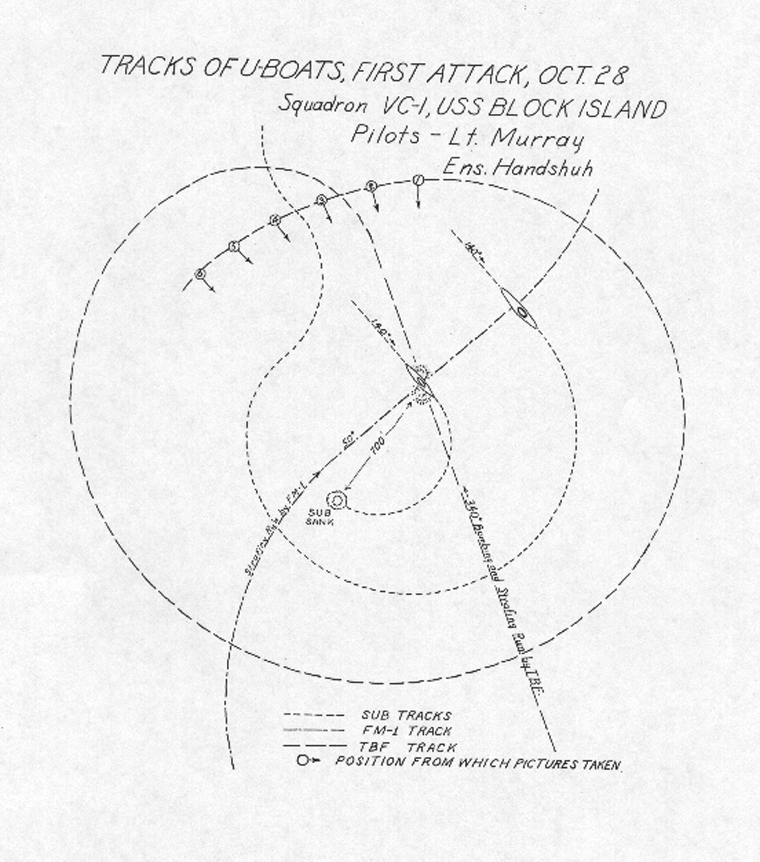
ENCLOSURE (E)
COMPOSITE SQUADRON ONE |
||
PHOTOGRAPHS |
||
| There were six photographs taken of the depth bombing attack and one of the mine attack. The radioman used a K-20 camera to obtain these, the first six being taken out of the port window by the radioman’s seat in the TBF tunnel and the seventh from stinger gun position (the having previously been removed) while lying prone. The negatives from the gun cameras of the fighter and TBF turret are forwarded. The TBF turret film does show the water and some indistinct objects. Obviously the range is great and with the limited facilities aboard ship, nothing of definite value can be found. Perhaps further study of this short strip will disclose further facts. | ||
| The lack of photographic evidence is discouraging though it is hoped the interpretation will be helpful. There is bound to be some wishful thinking, but the purpose is to bring out all possible details to aid in the assessment of this attack that was accurately delivered and which it is believed resulted in the sinking of the smaller of the two U-boats. | ||
| To left center can be seen the larger submarine showing what is probably the bow wave created by the conning tower as well as the wake. The wake comes back toward the camera and turns toward the right, close to 900. | ||
| Almost in the center of the picture is the probable position of the attacked U-boat. This discoloration of the picture could be caused either by the depth bomb residue or by oil slicks not noticeable to the observers for reasons described in the report. No image of the damaged submarine is noticed in this photograph. | ||
| The rapidity with which this and the following photographs were taken is shown distinctly by the relative position of the cloud formation in the successive photographs. | ||
| As mentioned this picture follows the other instantaneously. The conning tower of the larger submarine can be seen together with the wave it makes. Also the wake is a little straighter, indicating the forward motion. | ||
| Again the patch of water near the attacked U-boat is discernable. In the center of this circular disturbance, there seems to be a shape that might be the submarine on an angle of about 10 degrees to that of the waves. There may even be two white puffs of smoke over the center of the shape. | ||
| This is the last of a quick series of three pictures of practically the same subject. The conning tower of the larger submarine is visible in the left center and appears to have turned more broadside. This of course is helped by the motion of the plane which was toward the right of the pictures. | ||
| The patch of oil or depth bomb residue seems to be a little more compact and covering the entire circle rather than just the outer edge. | ||
| Here the plane is almost broadside to the larger submarine whose conning tower is quite noticeable as is the bow coming out of the water. There is not much forward motion if any and this larger sub probably is waiting to learn the damage done to the other. | ||
| The wake or the oil slick from the attacked submarine can be seen and there is some semblance of smoke being blown over to right. However neither pilot nor crewman observed any smoke coming from either U-boat. It is possible that the circular disturbance caused by the depth bombs can be seen on the camera side of the wake or oil slick. It is 4/10 to 5/10 inches toward the bottom of the picture and 8/10 inch in diameter. It is directly below the last noticeable part of the wake or oil slick. | ||
| This is the picture that may contain more evidence than any of the others. The conning tower and wake of the unattacked submarine are over on the left side of the picture. The wake can be followed back in its turn. At a point apparently directly ahead of the submarine, there is a small patch of water, greyish in color. Inspection of this with a magnifying glass will show a shape pointing at an angle of about 450 toward the upper left hand corner of the picture. This object is at such an angle that it is believed impossible to be a wave. The following enlargement brings it out more clearly. | ||
| ENCLOSURE (F) | ||
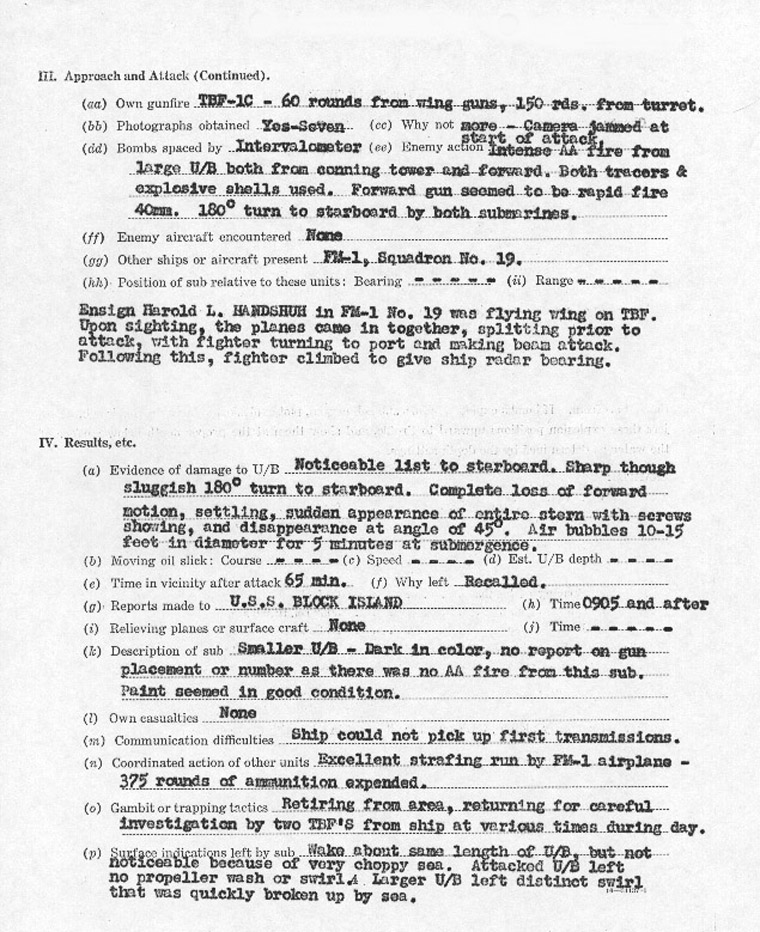
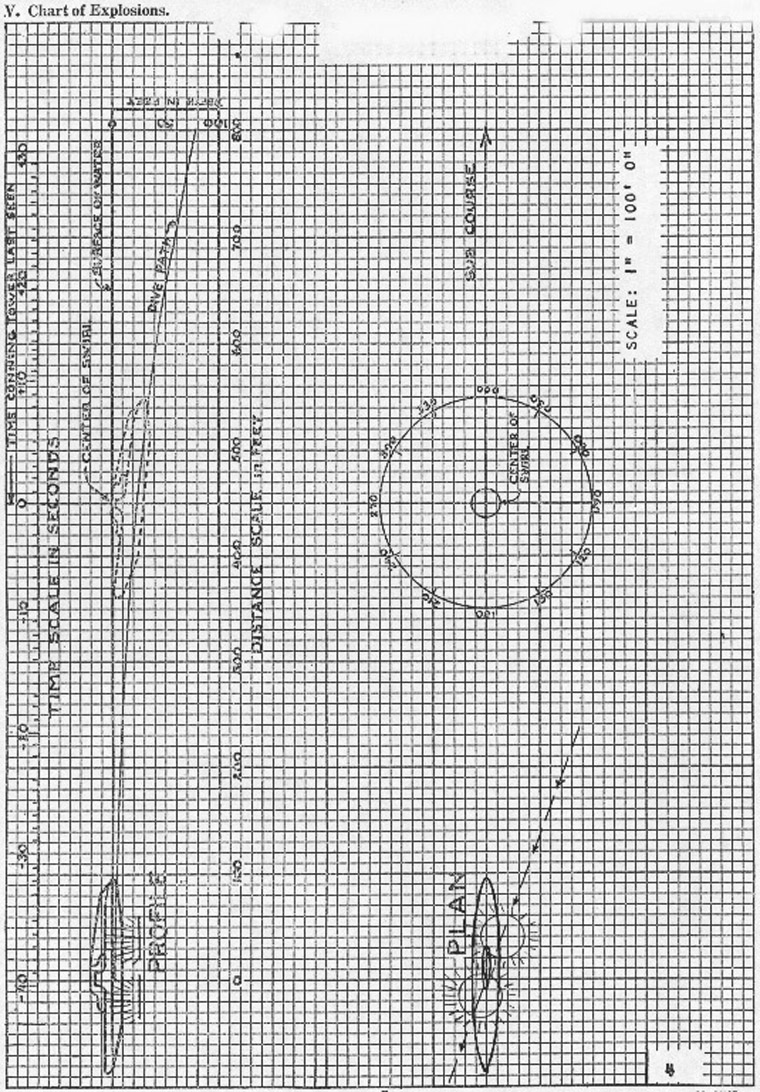
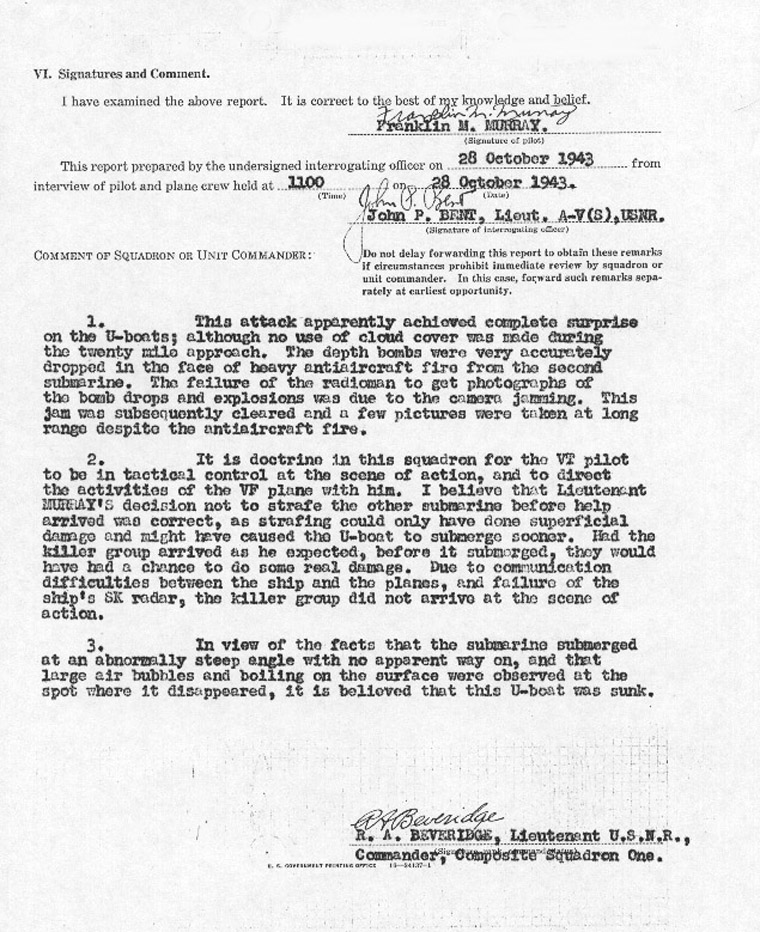
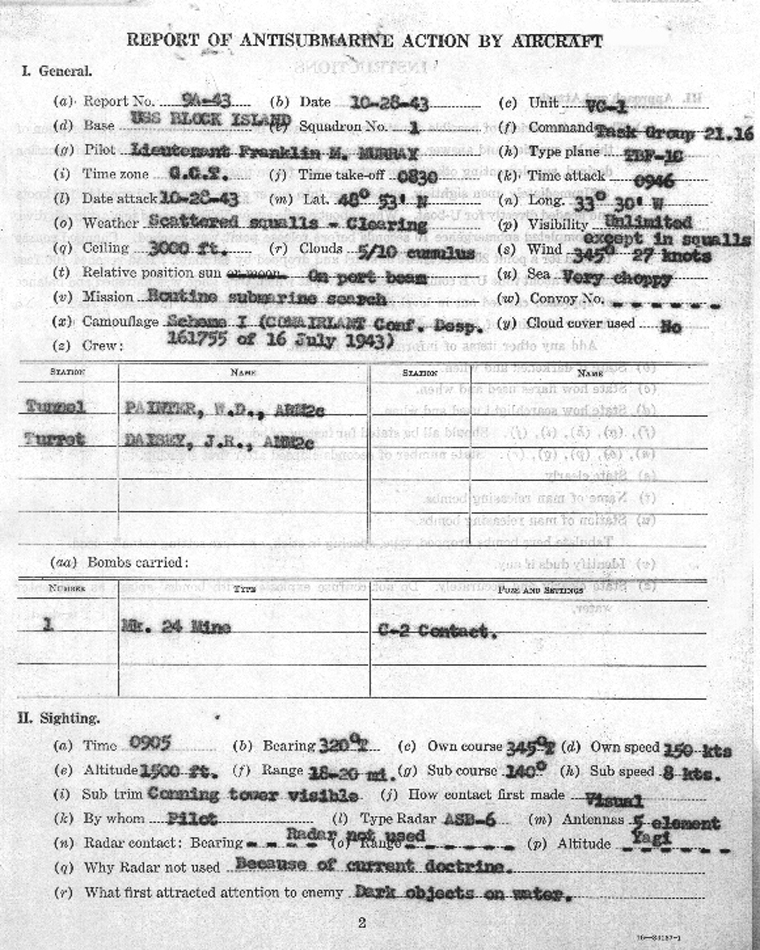
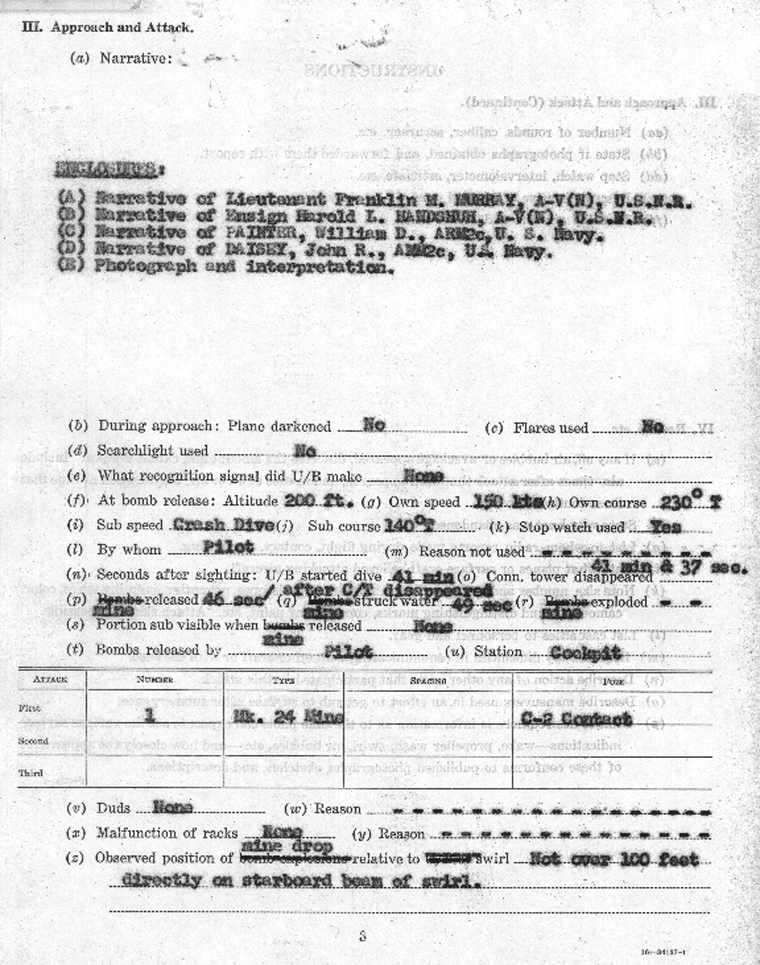
COMPOSITE SQUADRON ONE |
||
NARRATIVE OF MINE ATTACK. |
||
| 1. After the sinking of the smaller U-boat, the planes circled at about 2500 feet, some 1500 yards from the larger submarine. All personnel present at the time of the attack were impressed with the bulk of the larger submarine, not so much in beam, but primarily in length and massiveness of conning tower. Though the original dispatch from the U. S. S. BLOCK ISLAND reporting the attacks made mention of a 500-ton and a 740-ton U-boat, it is felt that the smaller was probably a 500-tonner and the larger, a 1200 ton “Kreuzer.” There was no raised platform on this large U-boat, nor other evidence of the 1600 ton class. The conning tower was bulky and stepped at least twice. No large forward gun was noticed, but there seemed to be fire from the forward end of the conning tower. The radioman noticed that the deck appeared to have longitudinal slats. | ||
| 2. Following the attack, the big U-boat circled 1800, apparently offering protection for, and help to, the damaged U/B. Upon the disappearance of the latter, the big one maneuvered erratically, making an apparent effort to keep the bow of the U-boat toward the planes. This may be further indication of larger caliber AA fire from the bow. The fighter did not strafe again for fear of driving the U-boat under before additional planes arrived, as such was expected momentarily. At one point, the TBF pilot thought this U-boat was starting to submerge, and, therefore, began approaching to drop the mine. Immediately, the U-boat regained its trim and put up very heavy AA fire, causing the pilot to break off his run. For 35 minutes the big U-boat stayed on the surface, firing at the planes. Then it dove and an immediate attack was launched with the Mark 24 Mine. | ||
| 3. The course of the submarine at time of submergence was 1400 T, speed 6-8 knots. It left a noticeable swirl that was quickly broken up in the choppy seas. | ||
(3a) |
||
COMPOSITE SQUADRON ONE |
||
NARRATIVE OF ATTACK-CONT’D |
||
| Forty-six seconds after the conning tower disappeared, the Mark 24 Mine was dropped from an altitude of 200 feet, air speed 150 knots, course 2300T. The mine hit the water not more than 100 feet directly abeam on the starboard side of the swirl. It was observed by the fighter pilot and the turret gunner of the TBF to start its underwater travel leaving a noticeable wake. During the time this wake was discernable (about 10 seconds), the mine had turned 300 to port. After that there was no indication of the mine’s course and no evidence of any underwater explosion. | ||
| 4. The TBF pilot searched this area as well as the area of the other attack for 30 minutes before being recalled to the ship. | ||
| 5. Although the mine was dropped within the area designated for its effectiveness, it was not placed along the last track of the U-boat. The reason for this was the desire to make as prompt an attack as possible. The drop was contrary to established Squadron doctrine, but apparently within the operative characteristics of the mine. With sea conditions as they were, it would have been impossible to notice any evidence of a deep-water explosion. | ||
| 6. With regard to sono-buoys, a purple one was dropped 5 seconds before the Mk. 24 mine. It was observed by the radioman to fall normally with parachute open and strike the water about 50 feet from the point where the mine entered the water. Although everything seemed satisfactory, the sono-buoy did not function after hitting the water. Not even water noises were heard. | ||
| 7. It is unfortunate that this one sono-buoy dropped did not operate. Squadron procedure is to carry out instructions as set forth by ASDEVLANT Sono-buoy Doctrine. In the excitement of the pilot’s first attack against a U-boat, this was not done. | ||
(3b) |
||
COMPOSITE SQUADRON ONE |
||
NARRATIVE OF MINE ATTACK-CONT’D |
||
| Nor were additional buoys dropped after either attack. Here again doctrine is to drop a regular pattern - - North, East, South, and West - - with the swirl or mine drop as the center-point of the square. This doctrine should have been followed, though it is well to point out the many difficulties encountered by the radioman in taking photographs while laying flat in the tunnel, in preparing sono-buoys for launching, in tuning various sono-buoys frequencies, listening to transmissions from the ship. | ||
| 8. It is interesting to speculate on the reason for this large U-boat remaining on the surface. Probably it was broadcasting information about the attack. There are, however, two other possibilities. First, it may have been trying to jam our frequency to prevent proper reception, and secondly, it may have been aware of the Mk. 24 Mine, knowing it would be attacked as soon as it submerged. Apparently by pretending to dive, it hoped for a chance of shooting down one of the planes, | ||
(3c) |
||
COMPOSITE SQUADRON ONE |
||
| This last picture is taken from the stinger position in the tunnel. It clearly shows the mine striking the water and starting its run. The spray is undoubtedly the aftermath of the splash and some white caps can be seen through the spray. At the upper left-hand edge of the spray is an object thought to be the sono-buoy. The cylindrical body of the sono-buoy as well as its parachute can be seen. Knowing that the length of the sono-buoy is 45 inches, some approximation can be made relative to the size of the mine splash. The air bubble at the leading edge of the splash is probably from the propellers and it seems that the other bubbles are about to come to the surface. | ||
| The choppy condition of the sea is also well shown in this picture which is taken looking directly back along the flight path of the plane. | ||
| ENCLOSURE (E) | ||
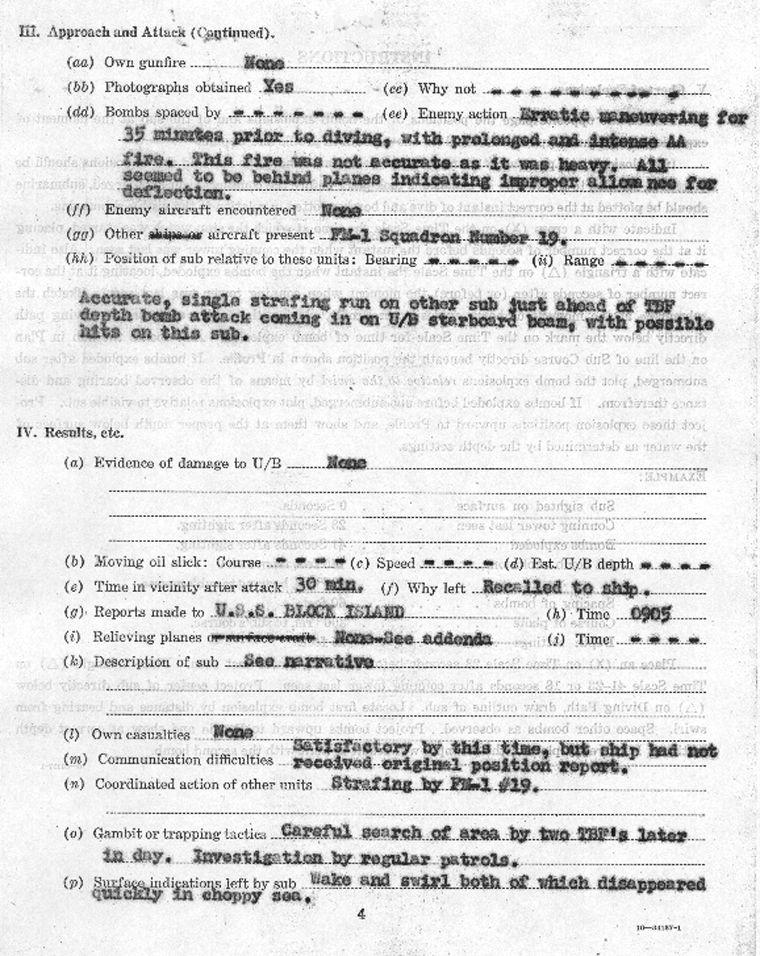
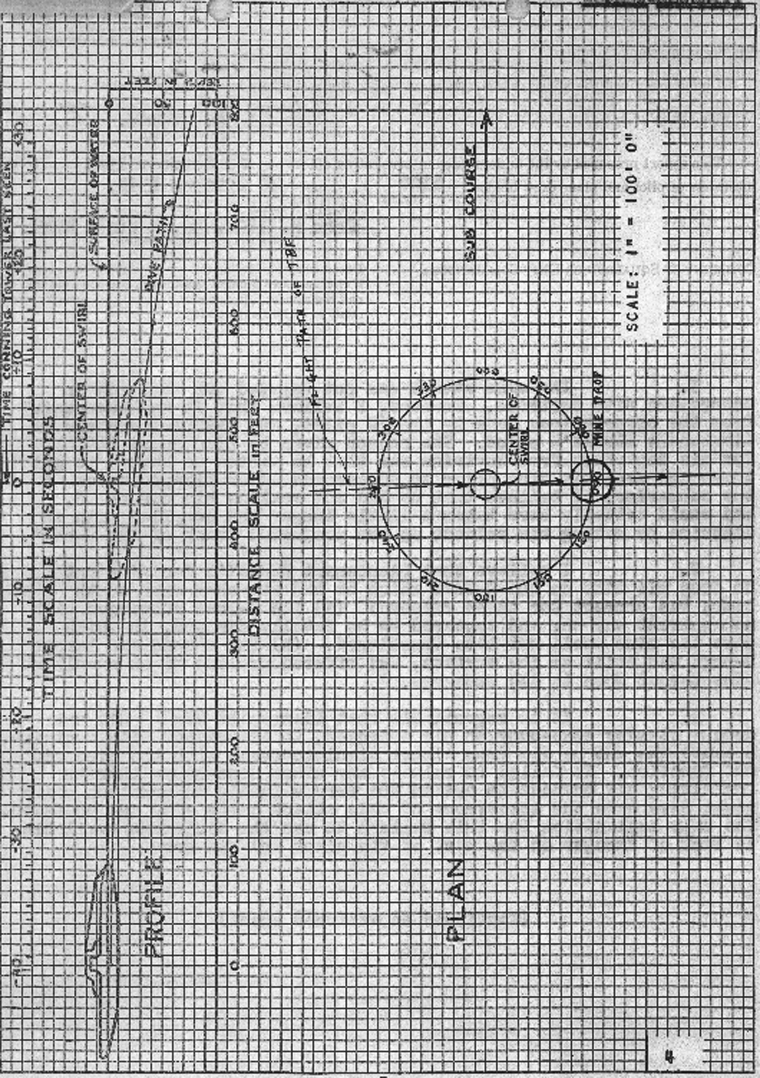
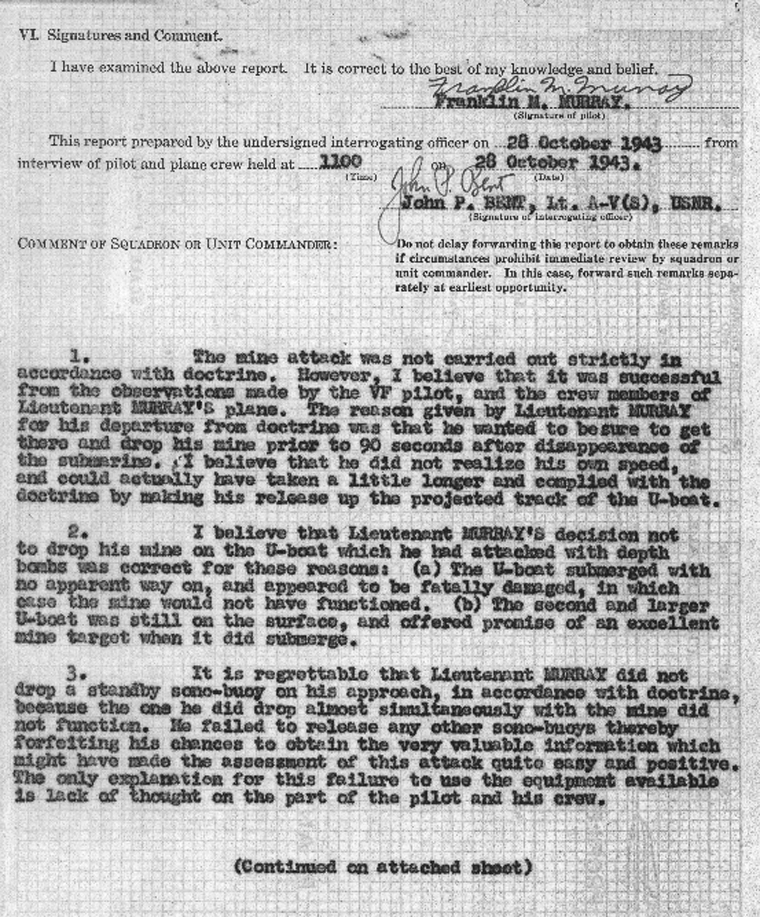
COMPOSITE SQUADRON ONE |
||
28 October 1943. |
||
| 4. The sono-buoy installation in the TBF airplane is far from ideal. It requires the radioman to perform additional functions at a very critical time, when he is concerned with checking over the bomber’s panel and arming devices, and preparing to take pictures of the bomb drops, as well as receiving instructions from the pilot on the interphone. The current installation also limits the plane’s speed for successful release of the buoy to 180 kts, which is sometimes undesirable for dropping the standby buoy when the pilot is making every effort to attack as soon as possible. This squadron is experimenting with the possibility of dropping the sono-buoys from the vacant shackles in the bomb bay, and will forward any recommendations which seem worthwhile at a later date. Information concerning critical high speeds and altitudes for release of the buoy will be appreciated by this command. | ||
| 5. If the mine continued to function properly, this submarine was probably sunk. | ||
| |
||
| R. A. BEVERIDGE, | ||
| Lieutenant, A-V(N), U.S.N.R., | ||
| Commander Composite Squadron One. | ||